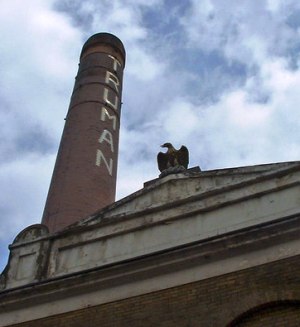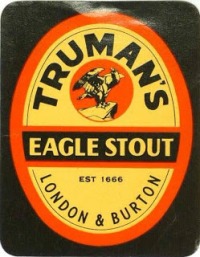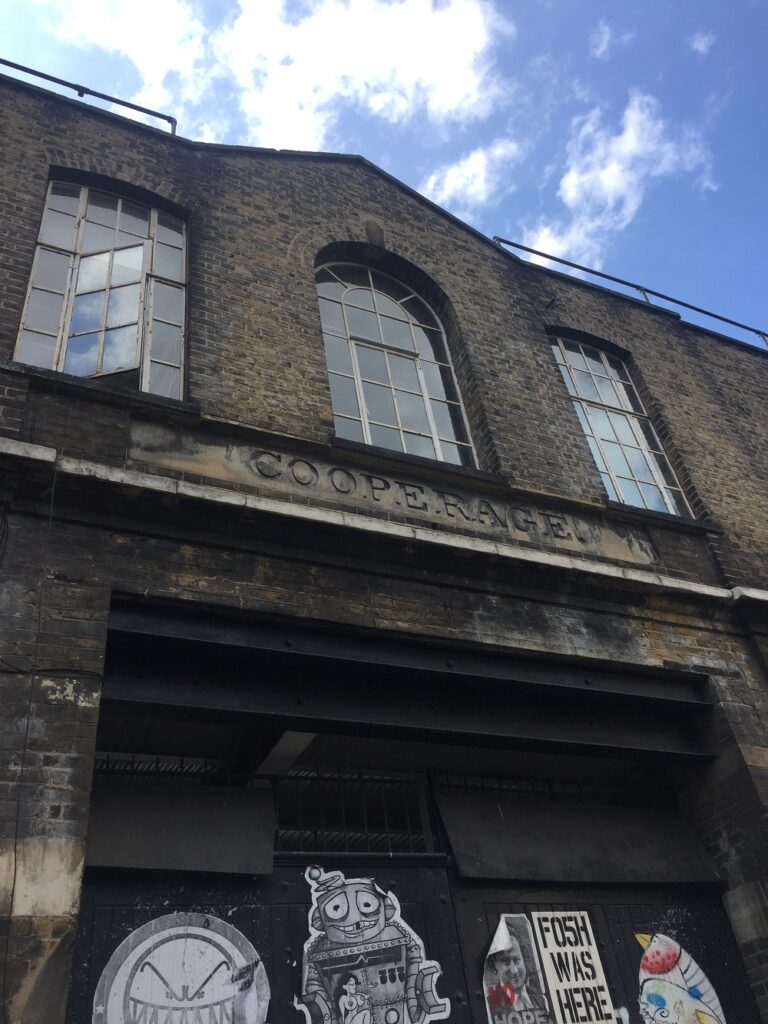This page covers the historic brewery. For more about the 21st century revival of the brand, see Big Penny and Truman (Old Truman Brewery).
Formerly Truman, Hanbury & Buxton
Closed brewery
Black Eagle Brewery, Hanbury Street E1 6QR (Tower Hamlets)
First sold beer: by 1669 (as Bucknall’s)
Ceased brewing: 1989
Brick Lane was little more than a country track through open fields when, sometime between 1666 and 1669, Thomas Bucknall opened his small Black Eagle brewery on Lolsworth Field, just off Brick Lane north of Spitalfields. Bucknall soon appointed Joseph Truman as brewer, and when he died in 1679, Truman leased and later bought the business.
Truman’s prospered in the following century under Joseph’s shrewd and ambitious grandson Benjamin (1700-80), who joined the board in 1722. By 1760, it was the third biggest porter brewery in London, producing almost 100,000 hl a year. Sampson Hanbury (1769-1835) became a partner in 1789: a skilful manager, he was a member of an extended network of Quaker bankers and merchants, and a relative of the Barclays who had recently invested in the Anchor brewery at Bankside (see Courage). In 1805, when output stood at 160,000 hl, the brewery was expanded to diversify into ales and a new steam engine installed.
Hanbury’s nephew Fowell Buxton (1786-1845) began working at the brewery in 1808, becoming a partner in 1811. Later an MP, he was a leading campaigner against slavery, an associate of prison reformer Elizabeth Fry, an opponent of the death penalty and a founder member of the Royal Society for the Prevention of Cruelty to Animals (RSPCA). Alongside its owners’ espousal of progressive causes, the brewery was noted for treating its workers relatively well by the standards of the day, offering free education to their children for example.
By the 1830s, Truman Hanbury & Buxton was producing 330,000 hl a year, and its Black Eagle trademark was known throughout the country. In 1873, when its capacity had grown to over 900,000 hl, it followed several other London breweries in extending production to Burton upon Trent, taking over a site on Derby Street built between 1860-65 by Phillips Brothers of Northampton and rebuilding it into a second Black Eagle Brewery. The company provoked criticism from London drinkers by blending beer brewed at both sites.
The London site continued to develop into the 20th century, with much of it rebuilt in neoclassical style in 1924, and a large cold store added in the 1950s. In 1970, it began brewing Tuborg lager, originally from Hellerup, Denmark, under license from Carlsberg, which had just bought the brand. With a new, modern brewhouse under construction in London, the Burton site was closed in 1971.

By now, Truman’s was London’s last big independent brewery: all the others of comparable size had become part of national groups. Given its size, and its estate of around 1,100 pubs not only in London but all over southern and eastern England and as far afield as the northeast, it was a prime target for takeover.
In 1971, both major brewing group Watney Mann, which was short of capacity, and hotel group Grand Metropolitan, which was keen to break into brewing and also had its eye on Watney, made bids for Truman’s. Grand Met was able to buy up almost 50% of the shares, pushing Watney out and taking over completely by the end of the year. The new brewhouse was commissioned as planned in 1972, by which time Grand Met had also acquired Watney, by 1974 merging both companies into Watney Mann Truman.
By this time, Truman’s brewed three cask ales, Special Mild (also called Prize Mild, 3%), Special Bitter (3.9%) and No 7 Prize Brew, and a keg bitter called Titan Keg (4%) as well as Tuborg (3.1%). It was also noted for a bottled pale ale, Ben Truman Export (5%), which had originated in Burton. Other bottles included light ale (3.4%), brown ale, Eagle stout and barley wine, plus a light pale ale in large cans known as Barbecue, inspired by similar products from Watney.
Following the takeover, cask was soon discontinued, but in 1977, in response to growing demand for the format, Truman’s launched Tap Bitter, a cask conditioned beer dispensed under air pressure. The initiative didn’t meet the approval of the executive committee of the Campaign for Real Ale (CAMRA), which promptly banned air pressure dispensed beer from all mention in CAMRA publications, provoking a major row with the Campaign’s Scottish branches, as this form of cask dispense was still widespread in Scotland. All cask beer was withdrawn again in 1981.
The axeing of cask, a widely disparaged rebrand and declining quality and investment as Grand Met began to lose interest in brewing all contributed to the decline of Truman’s, and in 1989 the brewery was finally closed, a decision also influenced by the obvious value of the land it occupied.
Where are they now?
The vast brewery site remained derelict until 1995 when it was sold to the Zeloof family. They had built a business in the East End rag trade into a successful clothing and fashion group, and also had interests in art and sculpture. Brick Lane has been a particularly multicultural and vibrant corner of London since at least the early 18th century, with successive waves of French Huguenot and then Eastern European Jewish settlers. By the 1980s it was a centre of the Bangladeshi community, noted for its restaurants, with the southern end officially renamed ‘Banglatown’ in 1997. The Zeloofs added another layer by initially encouraging artists and independent traders to rent space in the old brewery buildings, alongside more corporate clients like tech companies and data centres.
The area rapidly became a particularly ‘hip’ destination, noted for its buskers, street art, street food and lively nightlife. Gentrification inevitably followed, with longstanding residents increasingly challenged by rising rents and prices. In 2020, Truman Estates, the company set up by the Zeloofs to manage their property, submitted a development proposal for high rise offices and chain retail on part of the site. Amid major controversy, Tower Hamlets Council approved the proposal, sidelining an alternative plan developed by the local community. As of 2024, this decision is the subject of an appeal to the Supreme Court.
Though some Truman’s brands were subsequently brewed at Watney breweries, just two years after the brewery’s closure, in 1991, Grand Met sold its remaining brewing interests to Courage. Though a few brands were then sold to a management buyout known as Refresh UK (see Manns), most, including Truman’s, were quietly dropped. As explained elsewhere, Courage became Scottish Courage in 1995, the UK side of which was bought by Heineken in 2008. It seems nobody recognised the brand value of a name that was still fondly remembered particularly in East London and which was still displayed prominently on hundreds of pubs.
In 2009, two young professionals who worked on the brewery site conceived the ambitious idea of reviving Truman’s as an active beer brand. Initial negotiations with Heineken proved difficult — it seems staff weren’t initially aware they controlled the brand — but eventually it was licensed and later bought outright. Cuckoo-brewed beer first appeared in 2010, with the new Truman’s opening its own brewery, the Eyrie, in Hackney Wick in 2013, using the Truman yeast, retrieved from the National Collection of Yeast Cultures. Most beers were new recipes but included recreations of classic stouts and porters and Ben Truman Export.
The company struggled during the 2020 lockdowns and returned to cuckoo brewing in 2022. Later that year, it sold the brand to the owners of the old brewery site and renamed itself Big Penny. The new brand owners, who since 2020 sold a range of cuckoo-brewed beers under the Brick Lane brand at outlets on the site, have since revived the Truman name for these.
Things to see
Remarkably, nearly all the Truman buildings still stand as they did in 1989. The site sprawls across both sides of Brick Lane, and you can get a good idea of its impressive 4.5 ha extent by walking round it.
Following Quaker Street from the direction of Shoreditch High Street station, the brewery site begins at the corner with Grey Eagle Street, where large brown brick and glass 1970s buildings are visible behind the wall on the right. Further along you pass the side walls of a block from earlier in the 20th century.
Cross Brick Lane and continue on Buxton Street, past the former stables. Reaching the corner of Allen Gardens, look back for a view of the landmark 48 m Truman chimney, added in 1929. The lower wall a little further along surrounds the coopers’ yard, and turning right on Spital Street you pass the still-labelled entrance to the former Cooperage on the right.
A hole in the large black gates a little further on gives a glimpse of the extent of the yard, still largely undeveloped. This was the location for the initiation ceremony of ‘trussing the cooper’, when staff who had successfully completed their apprenticeship were covered in beer, spent grains, charred oak ashes and sundry other substances and rolled around in a large cask to mark their graduation to journeyman. Watch a film of this rather barbaric practice at Truman’s in 1954.
Turning right along Woodseer Street you pass more brewery walls and buildings on the right. On the left is a terrace of modest but attractive 19th century cottages built for brewery workers. Opposite these is the area currently proposed for development.
At the next corner you reach Brick Lane again: the buildings opposite are also part of the brewery site and you can see how the lane runs through the heart of it. The distinctive covered overbridge at 1st floor level to your left was a 1920s solution to uniting the two sides. The development plans envisage converting this into a restaurant.
Following Brick Lane under the bridge takes you into the heart of the site. Just past the bridge on the left, an arch gives access to an alleyway lined with restaurants, bars and independent shops. This is now known as Dray Walk, after the drays that once delivered beer and collected empty casks, but follows the line of the former Black Eagle Street. Lolsworth Field, site of the original brewhouse, was to the north of this lane. Dray Walk leads to a large yard, once used for logistics and now a street food market, known as Ely’s Yard after Ely Zeloof, the founder of the current owning company. The yard is now home to several artworks, described here.
The site’s most historic buildings are clustered a little further north, back along Brick Lane, past a blue plaque commemorating Fowell Buxton on the left (west) side. Stepping inside a small yard surrounded by decorative ironwork (91-95 Brick Lane E1 6QL), in front of you is a building with a glass frontage, considered inspirational when it was added by architects Arup in the 1970s as a grand entrance. Just inside this is a charming decorative canopy that was part of a previous entrance, but sadly this is off-limits in private space.
Immediately left is the Grade-II* Director’s House with its Black Eagle sign hanging over Brick Lane. This is likely an enlargement of an early 18th century counting house completed around 1745. There’s a story that Ben Truman ordered the improvements in an unsuccessful attempt to persuade his son to stay in London and take over the business. Later, it became Buxton’s principal residence. Facing it across the yard on the right is the Grade II-listed Brewer’s House, built in 1834.
Also from the 1830s is the Grade II-listed Engineer’s House (150 Brick Lane E1 6QL), opposite the yard on the east side of the lane. This incorporates a carriage entrance which is sometimes open, giving another view into the coopers’ yard. The buildings flanking the house, also Grade II-listed, partly date from the mid-18th century expansion overseen by Ben Truman, though with subsequent additions. The lengthy facade of the 1837 stable block stretches left: it’s surmounted by a pediment overlooked by a black eagle sculpture, but in gold. It was converted to a boiler house when the chimney was added in 1929. To the right of the house, a clock in a tympanum and a louvred cupola with weathervane top the vat house with its large first floor windows, built around 1800 for maturing porter. Inside is a forest of cast iron supporting columns.
Retracing your steps along Brick Lane, it’s worth continuing a little further south to turn right along Princelet Street, which was originally developed by Joseph Truman in 1705 as a sideline to brewing. Ben Truman once lived at the far end at no 4 (E1 6QH): the Grade II-listed Georgian house, now known as the ‘Red House’ for its rust-coloured shutters, remains part of the brewery estate.
Returning to Brick Lane, the brewery footprint clearly extends further south on the west side than on the east. To complete your circumambulation, turn left on Hanbury Street, by the 1960s glass and brick corner building with its impressive black eagle branding. This is used as a car park on weekdays and a market at weekends.
You pass the other end of Dray Walk and turn right along Corbet Place, with more branding visible on the building above the corner wall. Zigzagging to follow Grey Eagle Street, now noted for its street art, you walk under another overbridge which connects an outlying former brewery building on the left before returning to Quaker Street.
The Burton brewery, in contrast, was completely demolished following its closure, and replace with housing and light industrial buildings.
Updated 21 October 2024.
More London brewers
Closed London breweries







Great article! Thank you! Truman’s rebranded themselves as Truman’s, Hanbury & Buxton again in the early eighties, introducing 4 new cask ales, Bitter, Best Bitter, Samson Hanbury’s Strong Ale and Mild. All great products but too little and too late!
Typo sorry……..Truman , Hanbury & Buxton.